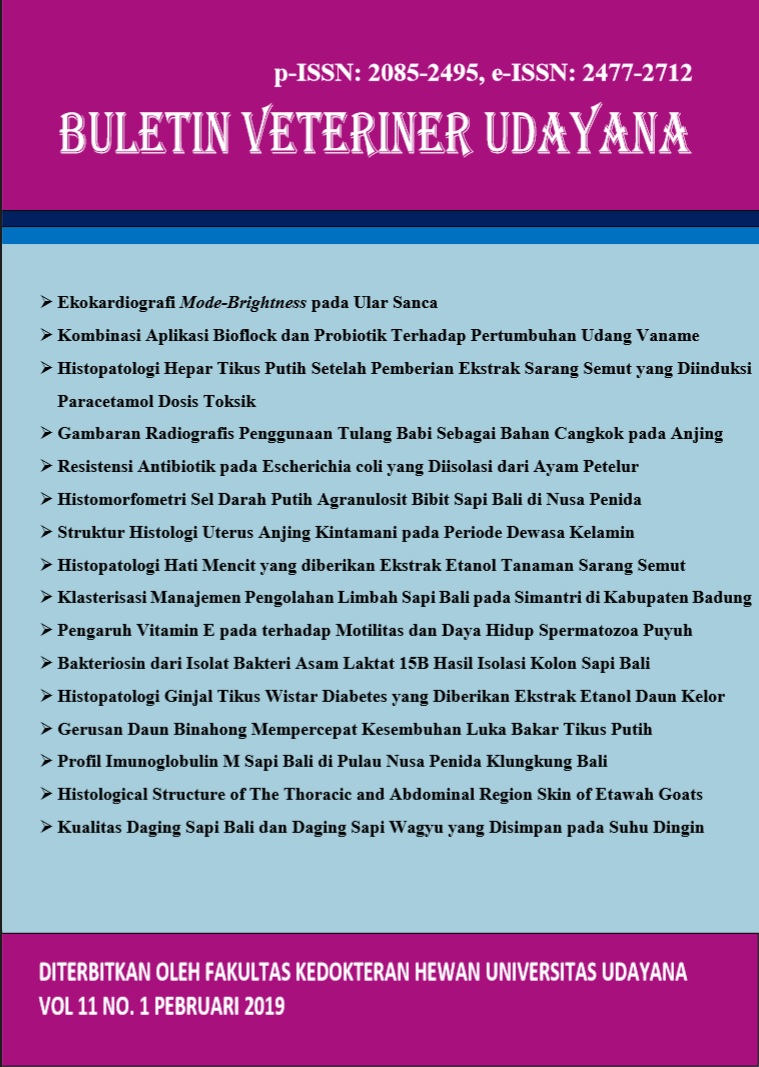THE QUALITY OF BALI AND WAGYU BEEF AT THE COLD STORAGE
Abstract
These study aims were to determine the quality of bali beef and Wagyu beef stored at 4oC. This study used a completely randomized factorial pattern design. Meat quality parameters studied included pH, water content, water holding capacity, and texture. The results showed that the pH value of Wagyu beef and bali beef increased during storage at cold temperatures. While the water content, water binding capacity, and texture of both types of meat have decreased. Significant changes occurred in observations of the fourth day. It can be concluded that the storage of Wagyu and bali beef at 4oC was not effective for a period of more than 3 days.
Downloads
References
Albrecht E, Gotoh T, Ebara F, JX Xu, Viergutz T, Nuernberg G, Maak S, Wegner J. 2011. Cellular conditions for intramuscular fat deposition in Japanese Black and Holstein steers. Meat Sci., 89: 13-20.
Barrett A, Jack B, R. Mhicelle R, Timoty R. 1998. Texture and Storage Stability of Process Beefstick as Affected by Glycerol and Moisture Levels. J. Food Sci., 63: 84-87.
Ballin NZ. 2010. Authentication of meat and meat products. Meat Sci., 86(3): 577-587.
Gebrehiwot HW, Balcha E, Hagos Y, Wrkelul K. 2018. Determination of pH and water holding capacity of beef from selected butcher shops of Mekelle, Ethiopia. J. Vet. Med. Anim. Health., 10(6): 159-164.
Gotoh T, Joo ST. 2016. Characteristics and Health Benefit of Highly Marbled Wagyu and Hanwoo Beef. Korean J. Food Sci. Anim. Resour., 36(6): 709-718.
Handiwirawan E, Subandriyo. 2004. Potensi dan Keragaman Sumberdaya Genetik Sapi Bali. Bogor. Bul. Ilmu Peternakan Indoesia., 14(3): 107-115.
Harper GS, Pethick DW. 2004. How might marbling begin? Australian J. Exp. Agric., 44(7): 653-662.
Hopkins DL, Ponnampalam EN, van de Ven RJ, Warner RD. 2014. The effect of pH decline rate on the meat and eating quality of beef carcasses. Anim. Prod. Sci., 54: 407-413.
Horii H, Sakurai Y, Kanbe Y, Kasai K, Ono K, Asada T, Mori T, Kobayashi M, Iguchi A, Yamada M, Hayashi M, Hodate K. 2009. Relationship between Japanese beef marbling standard numbers and intramuscular lipid in M. longissimus thoracis of Japanese Black steers from 1996 to 2004. Nihon Chikusan Gakkaiho., 80: 55-61.
Hwang YH, Kim GD, Jeong JY, Hur SJ, Joo ST. 2010. The relationship between muscle fiber characteristics and meat quality traits of highly marbled Hanwoo (Korean native cattle) steers. Meat Sci., 86: 456-461.
Judge MD, Arberle ED, Forrest JC, Hendrick HB, Merkel RA. 1989. Priciples Meat Science 2nd Ed. Kendall/Hunt Publishing Co, lowa.
Lawrie RA. 2003. Ilmu Daging. Edisi 5 Penerjemah Aminuddin parakkasi. Penerbit Universitas Indonesia, Jakarta.
Lonergan EH, Lonergan SM. 2005. Mechanisms of water-holding capacity of meat. Meat Sci., 71: 194-204.
Pereira PMCC, Vicente AFRB. 2013. Meat nutritional composition and nutritive role in the human diet. Meat Sci., 93: 586-592.
Prasetyo A, Kendriyanto. 2010. Kualitas daging sapi dan domba segar yang disimpan pada suhu dingin dengan pengawet asap cair. Seminar Nasional Teknologi Peternakan dan Veteriner. Proc. Pp. 843-848.
Radunz AE, Loerch SC, Lowe GD, Fluharty FL, Zerby HN. 2009. Effect of Wagyu- versus Angus-sired calves on feedlot performance, carcass characteristics, and tenderness. J. Anim. Sci., 87(9): 2971-2976.
Sarassati T, Agustina KK. 2015. Kualitas Daging Sapi Wagyu dan Daging Sapi Bali yang Disimpan pada Suhu -19oC. Indon. Med. Vet., 4(3): 178-185.
Sasaki K, Motoyama M, Yasuda J, Yamamoto T, Oe M, Narita N, MaiImanari, Fujimura S, Mitsumoto M. 2010. Beef texture characterization using internationally established texture vocabularies in ISO5492:1992: Differences among four different end-point temperatures in three muscles of Holstein steers. Meat Sci., 86(2): 422-429.
Smith SB. 2015. The Production of High-Quality Beef with Wagyu Cattle. Texas A&M University Department of Animal Science College Station, TX 77843-2471. Pp: 1-26
Suardana IW, Swacita IBN. 2009. Higiene Makanan. Udayana University Press. Denpasar.
Suwiti NK, Besung INK, Mahardika GN. 2017. Factors influencing growth hormone levels of Bali cattle in Bali, Nusa Penida, and Sumbawa Islands, Indonesia. Vet. World., 10(10): 1250-1254.
Weglarz A. 2010. Meat quality defined based on pH and colour depending on cattle category and slaughter season. Czech J. Anim. Sci., 55(12): 548-556.
Widiati R. 2014. Membangun Industri Peternakan Sapi Potong Rakyatdalam Mendukung KecukupanDaging Sapi. Wartazoa., 24(4): 191-200.





